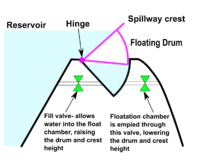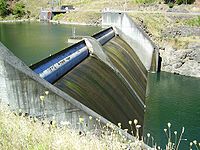


Floodgates, also called stop gates, are adjustable gates used to control water flow in flood barriers, reservoir, river, stream, or levee systems. They may be designed to set spillway crest heights in dams, to adjust flow rates in sluices and canals, or they may be designed to stop water flow entirely as part of a levee or storm surge system. Since most of these devices operate by controlling the water surface elevation being stored or routed, they are also known as crest gates. In the case of flood bypass systems, floodgates sometimes are also used to lower the water levels in a main river or canal channels by allowing more water to flow into a flood bypass or detention basin when the main river or canal is approaching a flood stage.
| Bulkhead gates are vertical walls with movable, or re-movable, sections. Movable sections can be lifted to allow water to pass underneath (as in a sluice gate) and over the top of the structure. Historically, these gates used stacked timbers known as stoplogs or wooden panels known as flashboards to set the dam's crest height. Some floodgates known as coupures in large levee systems slide sideways to open for various traffic. Bulkhead gates can also be made of other materials and used as a single bulkhead unit. Miter gates are used in ship locks and usually close at an 18° angle to approximate an arch. |  |
 |
Hinged crest gates, are wall sections that rotate from vertical to horizontal, thereby varying the height of the dam. They are generally controlled with hydraulic power, although some are passive and are powered by the water being impounded. Variations:
|
 |
 |
| Radial gates are rotary gates consisting of cylindrical sections. They may rotate vertically or horizontally. Tainter gates are a vertical design that rotates up to allow water to pass underneath. Low friction trunnion bearings, along with a face shape that balances hydrostatic forces, allow this design to close under its own weight as a safety feature. |  |
 |
| Drum gates are hollow gate sections that float on water. They are pinned to rotate up or down. Water is allowed into or out of the flotation chamber to adjust the dam's crest height. |  |
 |
|
 |
 |
| Fusegates are a mechanism designed to provide the controlled release of water in the event of exceptionally large floods. The design consists of free standing blocks (the fusegates) set side by side on a flattened spillway sill. The Fusegate blocks act as a fixed weir most of the time, but in excessive flood conditions they are designed to topple forward, allowing the controlled discharge of water. Multiple fusegates are generally set up side by side, with each fusegate designed to release under progressively extreme flooding, thus minimizing the impact of the floodwater on the river downstream.[1] The System was invented and patented by François Lempérière[2] for Hydroplus (Paris, France), subsidiary of GTM Entrepose. It has been installed on more than 50 dams around the world with sizes ranging from 1 m to more than 9 m in height. Fusegate are typically used to increase the storage capacity of existing dams or to maximize the discharge potential of undersized spillways. |  |
 |
| Mitre gates |

Valves used in floodgate applications have a variety of design requirements and are usually located at the base of dams. Often, the most important requirement (besides regulating flow) is energy dissipation. Since water is very heavy, it exits the base of a dam with the enormous force of water pushing from above. Unless this energy is dissipated, the flow can erode nearby rock and soil and damage structures.
Other design requirements include taking into account pressure head operation, the flow rate, whether the valve operates above or below water, and the regulation of precision and cost.[citation needed]
The force on a rectangular flood gate can be calculated by the following equation:

where:
 measured in pascal (Pa)
measured in pascal (Pa)
If the rectangular flood gate is submerged below the surface the same equation can be used but only the height from the water surface to the middle of the gate must be used to calculate the force on the flood gate.
|
| ||
|---|---|---|
| Management |
| |
| Hard engineering |
| |
| Soft engineering |
| |
| Related topics |
| |